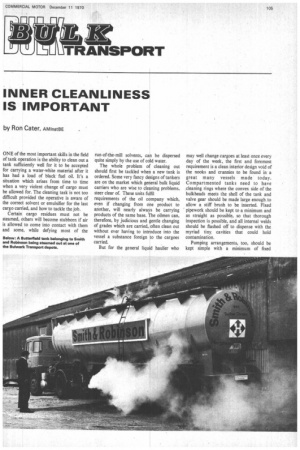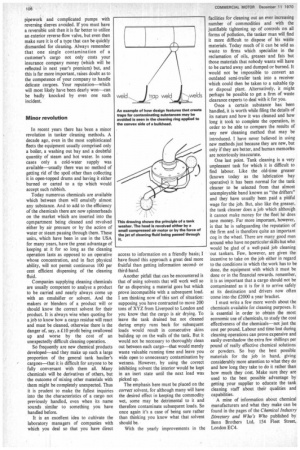INNER CLEANLINESS IS IMPORTANT
Page 107

Page 108

If you've noticed an error in this article please click here to report it so we can fix it.
by Ron Cater, AMInstBE
ONE of the most important skills in the field of tank operation is the ability to clean out a tank sufficiently well for it to be accepted for carrying a water-white material after it has had a load of black fuel oil. It's a situation which arises from time to time when a very violent change of cargo must be allowed for. The cleaning task is not too difficult provided the operative is aware of the correct solvent or emulsifier for the last cargo carried, and how to tackle the job.
Certain cargo residues must not be steamed. others will become stubborn if air is allowed to come into contact with them and some. while defying most of the run-of-the-mill solvents, can be dispersed quite simply by the use of cold water.
The whole problem of cleaning out should first be tackled when a new tank is ordered. Some very fancy designs of tankers are on the market which general bulk liquid carriers who are wise to cleaning problems, steer clear of, These units fulfil requirements of the oil company which, even if changing from one product to another, will nearly always be carrying products of the same base. The oilmen can, therefore, by judicious and gentle changing of grades which are carried, often clean out without ever having to introduce into the vessel a substance foreign to the cargoes carried.
But for the general liquid haulier who may well change cargoes at least once every day of the week, the first and foremost requirement is a clean interior design void of the nooks and crannies to be found in a great many vessels made today. Compartmented tanks need to have cleaning rings where the convex side of the bulkheads meets the shell of the tank and valve gear should be made large enough to allow a stiff brush to be inserted. Fixed pipework should be kept to a minimum and as straight as possible, so that thorough inspection is possible. and all internal welds should be flashed off to dispense with the myriad tiny, cavities that could hold contamination.
Pumping arrangements, too, should be kept simple with a minimum of fixed pipework and complicated pumps with reversing sleeves avoided. If you must have a reversible unit then it is far better to utilize an exterior reverse-flow valve, but even then make sure it is of a type that can be quickly dismantled for cleaning. Always remember that one single contamination of a customer's cargo not only costs your insurance company money (which will be reflected in next year's premium) but, and this is far more important, raises doubt as to the competence of your company to handle delicate cargoes. Your reputation—which will most likely have been dearly won—can be badly knocked by even one such incident.
Minor revolution In recent years there has been a minor revolution in tanker cleaning methods. A decade ago, even in the most sophisticated fleets the equipment usually comprised only a boiler, a washing out bay and a doubtful quantity of steam and hot water. In some cases only a cold-water supply was available—usually there was no method of getting rid of the spoil other than collecting it in open-topped drums and having it either burned or carted to a tip which would accept such rubbish.
Today numerous chemicals are available which between them will emulsify almost any substance. And to add to the efficiency of the chemicals there are now spinnerheads on the market which are inserted into the compartment being cleaned and revolved either by air pressure or by the action of water or steam passing through them. These units, which have been in use in the USA for many years, have the great advantage of keeping at it for so long as the cleaning operation lasts as opposed to an operative whose concentration, and in fact physical ability, will not permit continuous 100 per cent efficient dispensing of the cleaning fluid.
Companies supplying cleaning chemicals are usually competent to analyse a product to be carried and nearly always come up with an emulsifier or solvent. And the makers or blenders of a product will or should know the correct solvent for their product. It is always wise when quoting for a job to know how a cargo residue will react and must be cleaned, otherwise there is the danger of, say, a 10 profit being swallowed up and worse by the cost of an unexpectedly difficult cleaning operation.
So frequently are new chemical products developed—and they make up such a large proportion of the general tank haulier's cargoes—that it is difficult for anyone to be fully conversant with them all. Many chemicals will be derivatives of others, but the outcome of mixing other materials with them might be completely unexpected. Thus it is prudent to make the fullest inquiries into the the characteristics of a cargo not previously handled, even when its name sounds similar to something you have handled before.
It is an excellent idea to cultivate the laboratory managers of companies with which you deal so that you have direct access to information on a friendly basis; I have found this approach a great deal more fruitful than getting information secondor third-hand.
Another pitfall that can be encountered is that of using solvents that will work well so far as dispersing a material goes but which prove incompatible with a subsequent load. I am thinking now of this sort of situation: supposing you have contracted to move 200 tons of XYZ from Liverpool to London and you know that the cargo is air drying. To leave the tank drained but not cleaned during empty runs back for subsequent loads would result in consecutive skins building up on the walls of the tank. But it would not be necessary to thoroughly clean out between each cargo—that would merely waste valuable running time and leave you wide open to unnecessary contamination by wetness. However, by using the correct inhibiting solvent the interior would be kept in an inert state until the next load was picked up.
The emphasis here must be placed on the correct solvent, for although many will have the desired effect in keeping the commodity wet, some may be detrimental to it and therefore contaminate subsequent loads. So once again it's a case of being sure rather than thinking you know what that solvent should be.
With the yearly improvements in the facilities for cleaning out an ever increasing number of commodities and with the justifiable tightening up of controls on. all forms of pollution, the tanker man will find it more difficult to dispose of his waste materials. Today much of it can be sold as waste to firms which specialize in the reclamation of oils, greases and fats but those materials that nobody wants will have to be carted away and dumped or burned. It would not be impossible to convert an outdated semi-trailer tank into a receiver which could then be taken to a suitable tip or disposal plant. Alternatively, it might perhaps be possible to get a firm of waste clearance experts to deal with it for you.
Once a certain substance has been handled, it is worth while filing the details of its nature and how it was cleaned and how long it took to complete the operation, in order to be able to compare the results of any new cleaning method that may be introduced. I have never believed in using new methods just because they are new, but only if they are better, and human memories are notoriously inaccurate.
One last point. Tank cleaning is a very unpleasant task for which it is difficult to find labour. Like the old-time greaser (known today as the lubrication bay operative) it has been normal for the tank cleaner to be selected from that almost unemployable band known as "the drifters" and they have usually been paid a pitiful wage for the job. But, also like the greaser, the tank cleaner does a job which although it cannot make money for the fleet he does save money. Far more important, however, is that he is safeguarding the reputation of the firm and is therefore quite an important cog in the wheel. There are many good men around who have no particular skills but who would be glad of a well-paid job cleaning out tankers. Few, however, are given the incentive to take on the job either in regard to the conditions in which the work has to be done, the equipment with which it must be done or in the financial rewards. remember, it is as important that a cargo should not be contaminated as it is for it to arrive safely at its destination and drivers now often come into the £2000 a year bracket.
I must write a few more words about the chemicals available for cleaning purposes. It is essential in order to obtain the most economic use of chemicals, to study the cost effectiveness of the chemicals—not just the cost per pound. Labour and time lost during cleaning operations can prove expensive and easily overshadow the extra few shillings per pound of really effective chemical solutions or powders. So buy the best possible materials for the job in hand, giving considerably more attention to what they do and how long they take to do it rather than how much they cost. Make sure they are used to the best possible advantage by getting your supplier to educate the tank cleaning staff about their qualities and capabilities.
A mine of information about chemical manufacturers and what they make can be found in the pages of the Chemical Industry Directory and Who's Who published by Benn Brothers Ltd, 154 Fleet Street, London EC4.






























































































































































